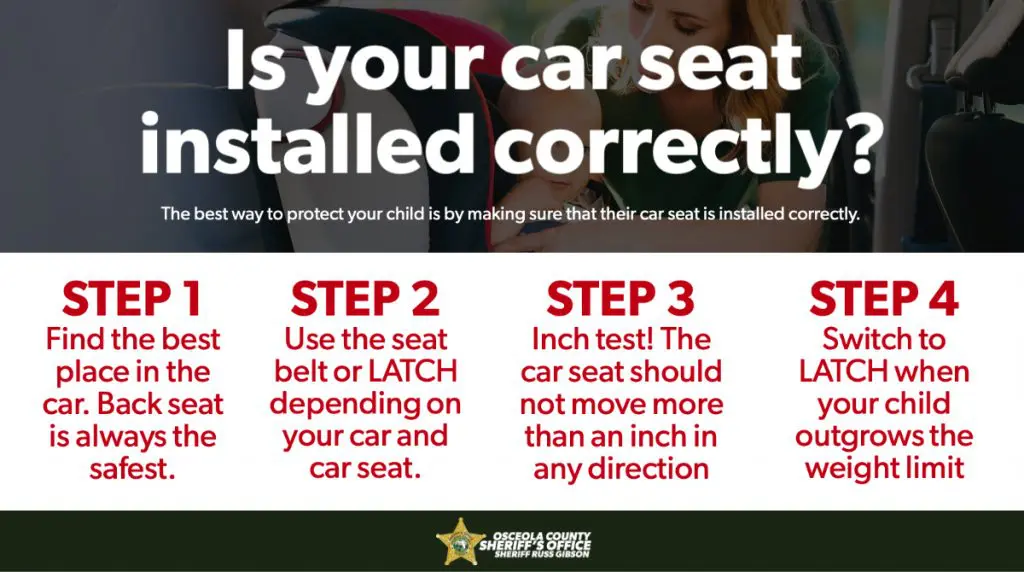The leading cause of death for children in the US is road injuries. The best way to protect them is to make sure their car seats are properly installed in your vehicle.
How to Install a Child Seat Properly
1. Find the Best Place in the Car
The back seat is the safest place for all children under the age of 13. Having children in the back seat keeps them further away from the most common type of impact as well as the front airbag. Airbags are meant to protect us, however, if you are sitting in the airbag deployment zone, it can be dangerous. Children usually aren’t aware of how to sit properly in the front seat putting them in this deployment zone. Airbag injuries come from being in this zone as the airbag is coming out at a speed of 200-400 miles per hour. At this speed, if you are too close, an airbag could cause serious injuries. The older children get, the stronger their bones and muscles become leaving them less likely to suffer from such serious injuries. Though your body is still growing at the suggested age of 13, you’re usually more aware of your body and able to withstand more energy from a car accident than an infant, toddler, or pre-adolescent.
2. Use the Seat Belt or LATCH:
- Seat Belt: Place the seat belt through the car seat using what’s known as the “belt path.” There should be arrows or directions on the car seat to show you the correct belt path. On forward-facing car seats, use a top tether when securing the seat. A Top tether is at the top of the car seat and is a piece of seat belt webbing with a hook attached to the end. The hook attaches to the tether anchor on your vehicle to help keep the seat from tipping forward during a crash or sudden stop. The anchor for the top tether is usually found on the top of your vehicle seats.
- LATCH: LATCH stands for Lower Anchors and Tethers for Children. This option allows you to secure the car seat without using a seat belt. There are two lower attachments on the car seat that clip or hook to the lower anchors usually located near the seat belt buckle in between your vehicle seats. Sometimes you have to search like you dropped something in between your seats to find them, but they are there.
LATCH cannot be used in unison with the seat belt method, you have to choose the one that best suits your car and car seat. LATCH is also not available in every seat in your car, so you should check your car’s manual if you’re having trouble. If you choose the middle seat as your car seat location, please make sure it has the anchors. Not all middle seats have lower anchors, and you cannot “borrow” anchors from the other seats or the child’s seat will not be secured properly. If your car seat is forward-facing, you should still use a top tether with LATCH.
3. Inch Test
A car seat that is properly secured should not move more than one inch from front to back or side to side when pulled at the seat belt path. This test applies no matter which direction your car seat is facing or which option you choose to secure it.
4. Latch Weight Limit
The car seat label lists the weight limit for your car seat and LATCH. When your child outgrows the weight limit, simply switch from the LATCH system to the seat belt.
So now that your car seat is secured in the car, here is how to get your child in the seat safely:
When buckling your baby into their car seat, make sure that you are using the harness correctly. Ensuring that the harness fits and is in place properly is necessary to keeping your child safe.
First, make sure that the chest clip is in line with the child’s armpits. Placing it too low or too high can be dangerous in the case of an accident. Also, only securing the chest clip is not enough. Make sure that you are also using the buckle between their legs.
Then, make sure that the straps are tight enough. You want the straps to be “as snug as a hug”, with no room for slack.
Lastly, if you need to keep baby warm while in the car, make sure to place the blanket OVER the harness. Don’t add any other accessories to your baby’s car seat unless they’re approved by the manufacturer or they came with the car seat.

